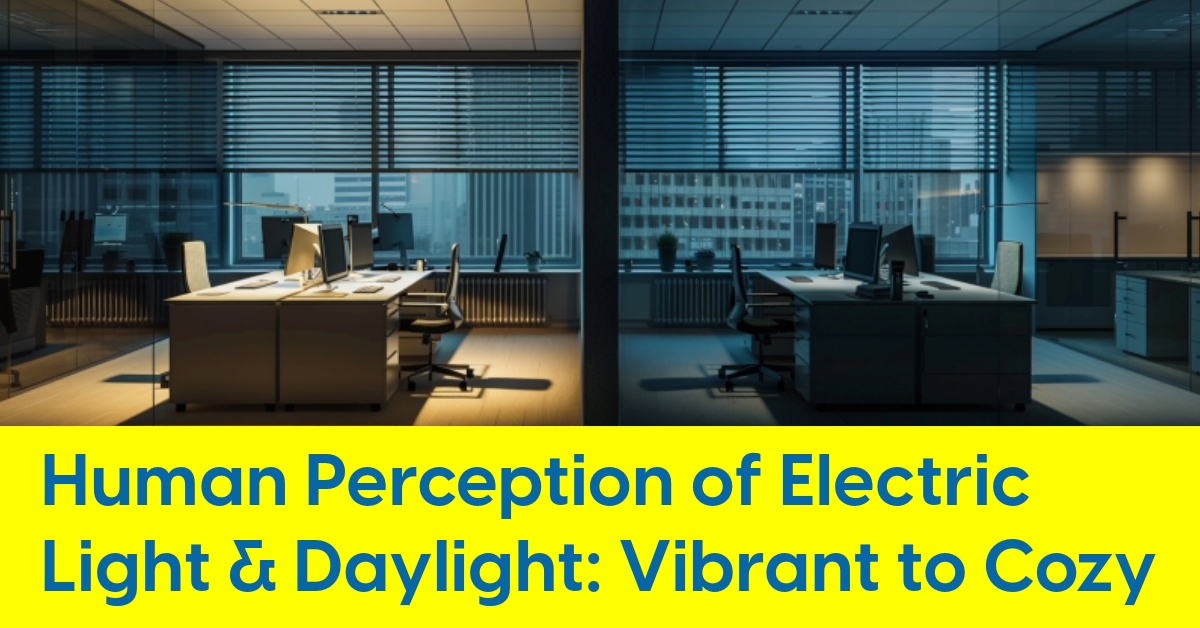June 4, 2024
Human Perception of Electric Light & Daylight: Vibrant to Cozy
How do we perceive various configurations of window blinds, outdoor skies and CCTs?
Creating healthy and comfortable living and working spaces is a fundamental aspect of sustainable building practices. As people spend over 90% of their time indoors, optimizing indoor lighting is crucial for enhancing quality of life by positively influencing physiological and psychological aspects. The interplay between daylight and electric light is particularly significant in shaping human perceptions of indoor environments.
A new study by researchers from Carnegie Mellon University and the University of Oregon reveals that the interplay between daylight and electric light significantly influences how people perceive indoor spaces. Niloofar Nikookar, Azadeh Omidfar Sawyer, and Mayank Goel from Carnegie Mellon University, along with Siobhan Rockcastle from the University of Oregon, found that factors such as color temperature and window blind positions can substantially affect whether an office space feels cozy, tense, or productive.
The study "Investigating the Impact of Combined Daylight and Electric Light on Human Perception of Indoor Spaces" examined 16 different lighting scenarios in an office environment, considering factors such as sky condition (sunny vs. overcast), shading blinds position (open vs. closed), presence of electric light (on vs. off), and Correlated Color Temperature (CCT) (2700 K, 4000 K, and 6500 K).
Participants included 26 individuals (11 females, 14 males, and one undisclosed), aged between 18 and 50. They evaluated the office ambiance under various lighting conditions using semantic differential scales. The statistical analysis included ANOVA, Friedman, and Kruskal-Wallis tests to assess the influence of these variables on different perceptions of the lighting conditions.
Testing different cocktails of window blinds, outdoor skies and CCTs
The analysis revealed significant effects of CCT and blinds on participants’ perceptions. CCT influenced perceptions such as "Coziness," "Tenseness," "Calming," "Likability," and "Monotonous." Blinds significantly impacted perceptions of "Lively," "Impersonal," "Exciting," and "Vibrant." Notably, the sky condition alone did not significantly affect perceptions but interacted with blinds and CCT to influence perceptions like "Productive" and "Likability."
The interaction between blinds and CCT was significant across most perceptions, except "Calming." For instance, 4000 K lighting was generally rated more positively in spaces without blinds but received mixed reviews in spaces with blinds. These findings underscore the importance of considering both daylight and electric light in tandem when designing indoor lighting.
The study found that both blinds and color temperature (CCT) significantly influenced participants' perceptions of the room's ambiance. Blinds particularly affected impressions of liveliness, impersonality, excitement and vibrancy, while CCT impacted feelings of coziness, tension, calmness, likability and monotony.
Examples of Perception Interplay
Interestingly, sky condition alone—whether it was sunny or overcast—didn't significantly sway indoor lighting perceptions. This suggests that participants' feelings about the room's ambiance didn't change markedly just because it was a bright, sunny day or a dim, cloudy one.
When sky condition interacted with other factors, it did influence perceptions. For instance, its interaction with CCT (color temperature) influenced the room's likability. This means that while a sunny sky by itself didn't make the room more likable, a sunny day combined with a warm 2700K light might have made the space feel cozier and more inviting compared to the same warm light on an overcast day.
Similarly, when sky condition interacted with blinds, it affected perceptions of liveliness, productivity, likability, and vibrancy. For example, on a sunny day with blinds open, letting in abundant natural light, participants might have found the room more lively and vibrant than on an overcast day with open blinds. However, this pattern reversed when blinds were closed. Under overcast skies with closed blinds, participants rated the room as slightly more productive and less monotonous compared to a sunny day with closed blinds. This suggests that while direct sunlight might be distracting or create glare when blinds are open, the softer, diffused light of an overcast day could be less disruptive, making the space feel more conducive to work.
Neither seat location nor age significantly affected participants' lighting perceptions.
Researchers' Discussion
The study highlights the complexity of optimizing indoor lighting to meet individual needs and preferences. For example, the presence of blinds under overcast skies improved perceptions of the space, contrary to common usage patterns. This suggests that blinds might play a crucial role even under less sunny conditions, and their impact could vary based on their color, texture, and other characteristics.
The findings emphasize the need for adaptable lighting solutions in architecture and lighting design. Smart building systems could benefit from these insights, allowing for dynamic adjustment of lighting based on real-time environmental data and user preferences. However, controlling dynamic lighting in shared office spaces remains challenging due to diverse user needs.
This study provides insights into the combined effects of daylight and electric light on human perception of indoor spaces. The findings highlight the importance of creating personalized lighting solutions that can adapt to changing external conditions and occupant preferences, enhancing the health, comfort, and sustainability of indoor environments. Future research should explore additional factors influencing lighting perceptions and validate these findings in diverse real-world settings.











